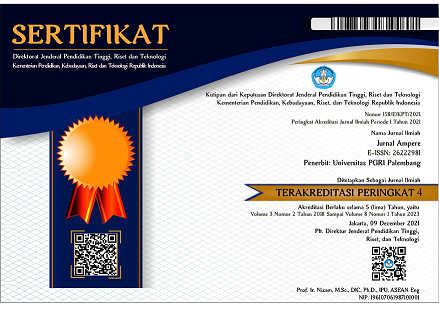Modifikasi Model Propagasi Ericsson Jaringan Lte-1800 Mhz Pada Daerah Lepas Pantai Dengan Menggunakan Least Square Method
DOI:
https://doi.org/10.31851/ampere.v5i1.4734Keywords:
4G-LTE network, ericcson model, propagationAbstract
The 4G network has the advantage of accessing data at a higher speed compared to its predecessor, namely 3G. The purpose of this is to see the fluctuation of LTE-1800 MHz signal in the offshore area then modify the Ericsson propagation modeling to get the results with real conditions (real) and accurate. As well as making comparisons of calculation results from existing Ericsson Propagation modeling and comparisons of the results of modifying modeling that can. The method used in this research is four stages: 1). determination of initial data, 2). tools and materials, 3). data grouping and 4). pathloss calculation. The research was conducted in a coastal area off the shore in Panjang district, Bandar Lampung district. Testing the quality of the 4G-LTE network in offshore coastal areas is carried out by measuring several important influencing parameters such as RSRP (Reference Signal Recived Power). All activities are carried out using software devices. Probe by wawe. Analysis of the results before the value 173.5986043 dB obtained from the modeling results from the accurate results of 16.48853263 dB in this calculation using the Ericsson propagation model.References
D. Saputro, “Analisis Perencanaan Jaringan LTE di Pita Frekuensi 3500 MHz dengan Mode TDD dan FDD,†Telekomunikasi dan Komputer, vol. 7, pp. 35-60, 2016.
F. K. Utami dan H. Alfin , “Perencanaan Femtocell 4G LTE 1800mhz Studi Kasus Gedung Baru ST3 Telkom Purwokerto,†2016.
W. Pradono, “Dampak Sosial Ekonomi dan Peran Pemerintah Daerah dalam Perkembangan Teknologi Pitalebar di Indonesia,†Buletin Pos dan Telekomunikasi, vol. 14, pp. 131-146, 2016.
M. Marzuki dan B. Irawan, “Analisa Propagasi Gelombang Continuous Wave Pada Radio Amatir di Frequency 21 MHz,†Telekomunikasi dan Komputer, vol. 7, pp. 213-236, Desember 2016.
C. Emeruwa dan P. Iwuji, “Determination Of A Pathloss Model For Long Term Evolution (Lte) In Yenagoa,†Engineering and Science, vol. 7, no. 10, pp. 38-44, 2018.
I. Dewanti, A. Wahyudin dan A. Hikmaturrokhman, “Analisis Perbandingan Passive Repeater Back-To-Back,†SENATEK 2017, pp. 1-8, 2017.
F. Nasution, D. Faiza dan K. Budayawan, “Analisis Model Propagasi Komunikasi Bergerak Pada Sistem Gsm Di Pt. Xl Axita Padang,†Vokasional Teknik Elektronika & Informatika, pp. 11-21, Januari-Juni 2016.
A. Fajar dan E. Devia, “Analisa Dan Optimalisasi Jaringan 4g Lte Dengan Metode Electrical Tilt Menggunakan Drivetest,†JURNAL JIIFOR, vol. 1, pp. 78-87, 2017.
F. R. Hariri, “Metode Least Square Untuk Prediksi Penjualan Sari Kedelai Rosi,†SIMETRIS, vol. 7, pp. 731-736, November 2016.
B. Alfaresi, T. Barlian, F. Ardianto dan M. Hurairah, “Path Loss Propagation Evaluation and Modelling based ECC-Model in Lowland Area on 1800 MHz,†Journal of Robotics and Control (JRC), pp. 167-172, 2020.
Downloads
Published
How to Cite
Issue
Section
License

Jurnal Ampere is licensed under a Creative Commons Attribution-ShareAlike 4.0 International License.
Authors who publish with this journal agree to the following terms:
- Authors retain copyright and grant the journal right of first publication with the work simultaneously licensed under a Creative Commons Attribution License that allows others to share the work with an acknowledgement of the work's authorship and initial publication in this journal.
- Authors are able to enter into separate, additional contractual arrangements for the non-exclusive distribution of the journal's published version of the work (e.g., post it to an institutional repository or publish it in a book), with an acknowledgement of its initial publication in this journal.
- Authors are permitted and encouraged to post their work online (e.g., in institutional repositories or on their website) prior to and during the submission process, as it can lead to productive exchanges, as well as earlier and greater citation of published work.





